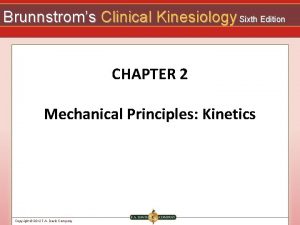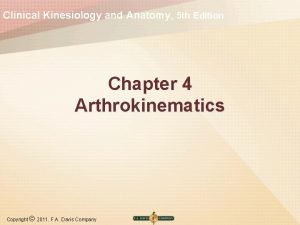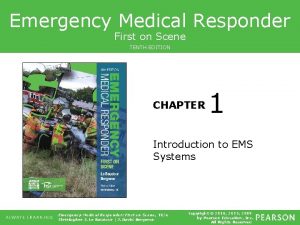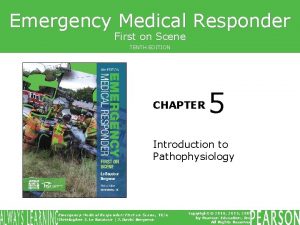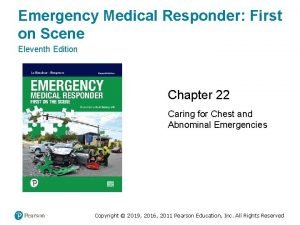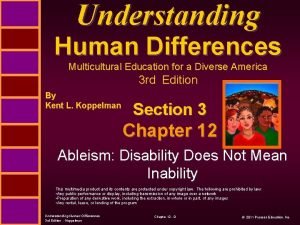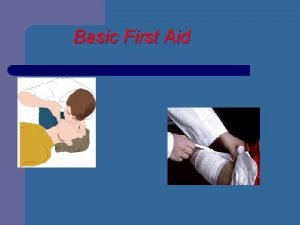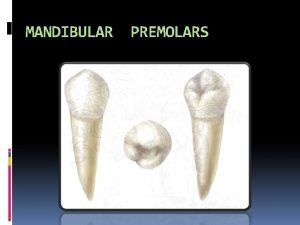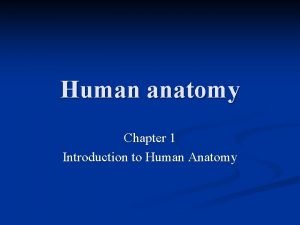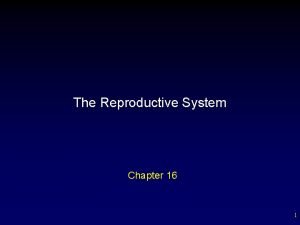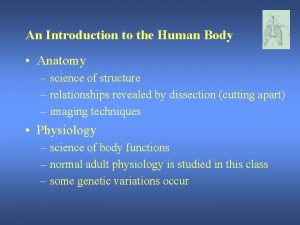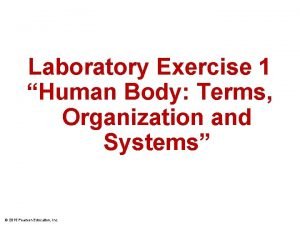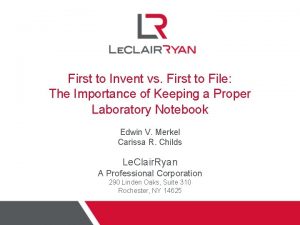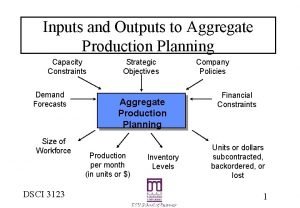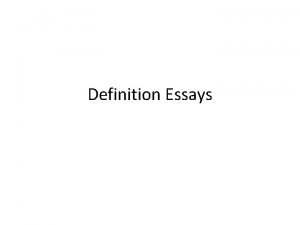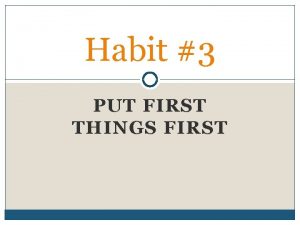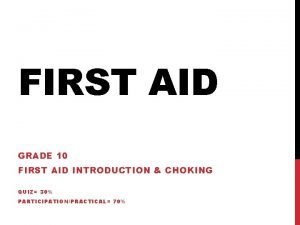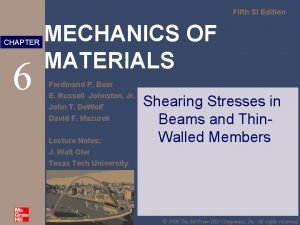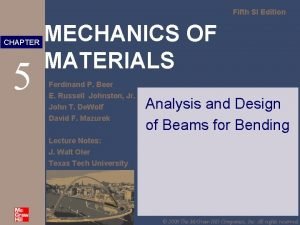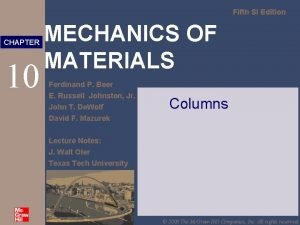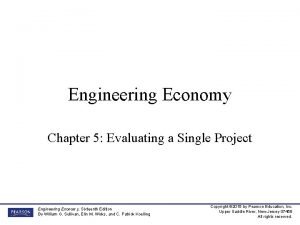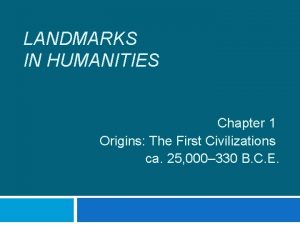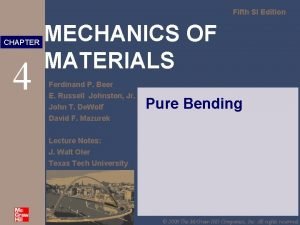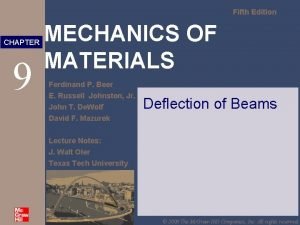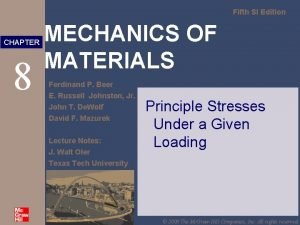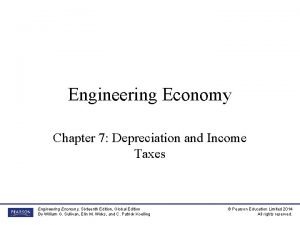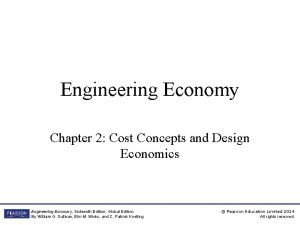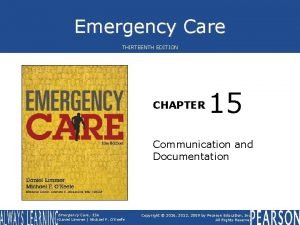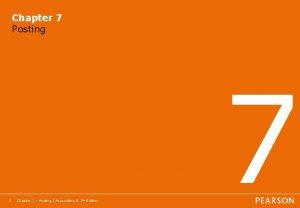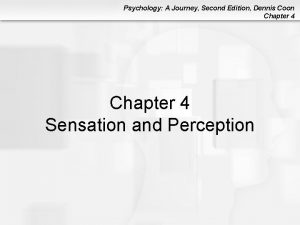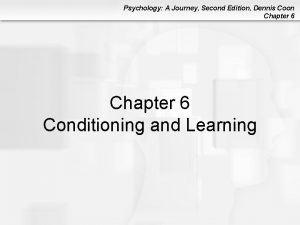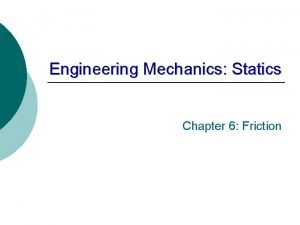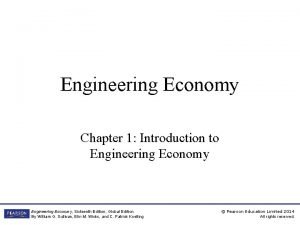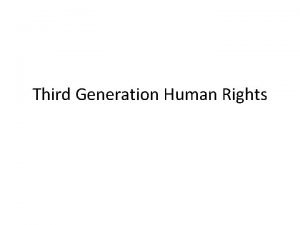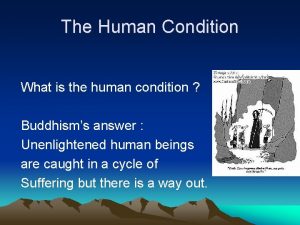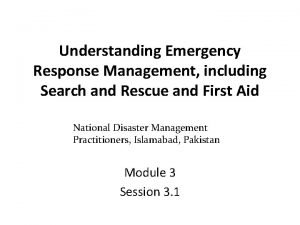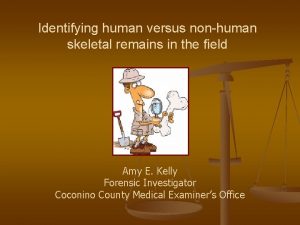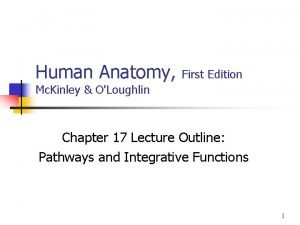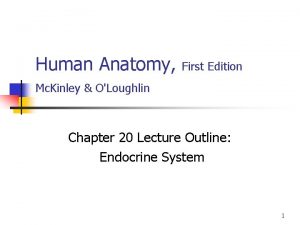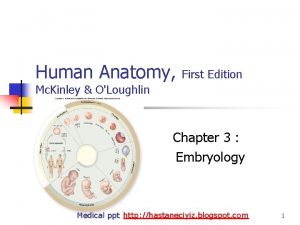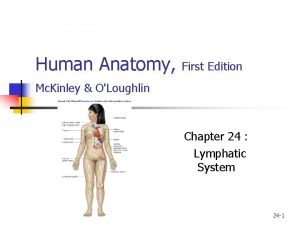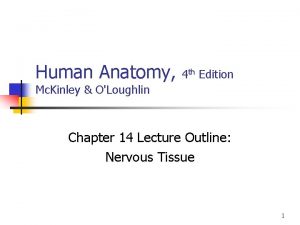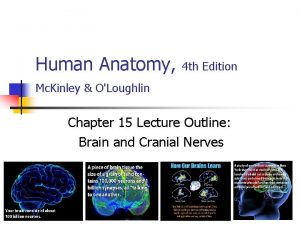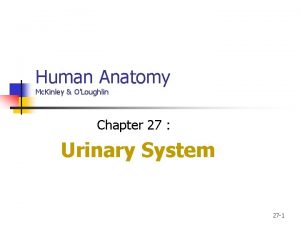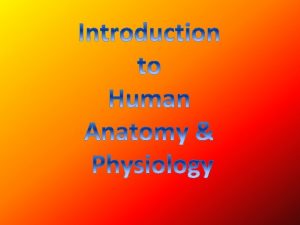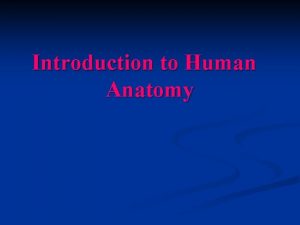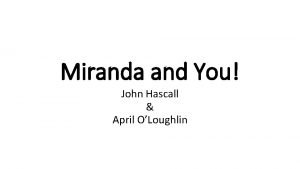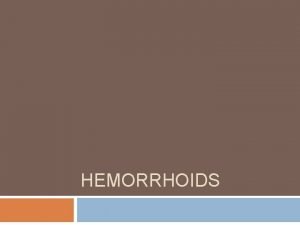Human Anatomy First Edition Mc Kinley OLoughlin Chapter




















































































































- Slides: 116

Human Anatomy, First Edition Mc. Kinley & O'Loughlin Chapter 7: Axial Skeleton 1

Skeletal System n n n The bones of the skeleton form an internal framework to support soft tissues, protect vital organs, bear the body’s weight, and help us move. Typically, there are 206 bones in an adult skeleton, although this number varies in some individuals. A larger number of bones are present at birth, but the total number decreases with growth and maturity as some separate bones fuse. 2

Skeletal System n The axial skeleton is composed of the bones along the central axis of the body, n n the skull the vertebral column the thoracic cage The appendicular skeleton consists of the bones of the appendages n n upper and lower limbs the bones that hold the limbs to the trunk of the body. 3

4

5

The Skull n n Cranial bones form the rounded cranium, which completely surrounds and encloses the brain. Facial bones form the bones of the face. They also n n protect the entrances to the digestive and respiratory systems as well as provide attachment sites for facial muscles 6

The Mandible n n The lower jaw is formed by the mandible. The prominent “chin” of the mandible is called the mental protuberance. 7

Cavities of The Skull n n The largest cavity is the cranial cavity, which encloses, cushions, and supports the brain. The skull also has several smaller cavities, including the orbits (eye sockets), the oral cavity (mouth), the nasal cavity, and the paranasal sinuses. 8

9

10

Markings of the Skull n Numerous bone markings n n n Canals; bony tubes through a thick bone Fissures; cracks; longer than wide Foramina; holes in thin bone n passageways for blood vessels and nerves 11

Sutures of the Skull n n Sutures are immovable fibrous joints that form the boundaries between the cranial bones. Dense regular connective tissue seals cranial bones firmly together at a suture. Allow the cranium to grow and expand during childhood. In adulthood, when cranial growth has stopped, the sutures fuse and are obliterated. 12

13

14

15

16

17

18

19

20

21

22

23

24

25

26

27

28

29

30

31

32

33

34

35

36

37

38

39

40

41

42

43

44

45

46

47

48

49

50

51

52

53

54

55

56

Insert Fig. 7. 9 superior view of skull 57

Insert Fig. 7. 9 superior view of skull 58

Insert Fig. 7. 9 superior view of skull 59

Insert Fig. 7. 9 superior view of skull 60

Insert Fig. 7. 9 superior view of skull 61

Insert Fig. 7. 9 superior view of skull 62

Insert Fig. 7. 9 superior view of skull 63

Insert Fig. 7. 9 superior view of skull 64

Insert Fig. 7. 9 superior view of skull 65

Insert Fig. 7. 9 superior view of skull 66

Insert Fig. 7. 9 superior view of skull 67

Insert Fig. 7. 9 superior view of skull 68

Insert Fig. 7. 9 superior view of skull 69

Insert Fig. 7. 9 superior view of skull 70

Insert Fig. 7. 9 superior view of skull 71

Insert Fig. 7. 9 superior view of skull 72

Insert Fig. 7. 9 superior view of skull 73

Insert Fig. 7. 9 superior view of skull 74

Insert Fig. 7. 9 superior view of skull 75

Insert Fig. 7. 9 superior view of skull 76

Insert Fig. 7. 9 superior view of skull 77

Insert Fig. 7. 9 superior view of skull 78

Insert Fig. 7. 9 superior view of skull 79

80

81

82

83

84

85

86

87

88

89

90

91

Sinuses n n n Have a mucous lining that helps to humidify and warm inhaled air. Cause these skull bones to be lighter. Provide resonance to the voice. 92

93

94

95

Auditory Ossicles n Three tiny ear bones called auditory ossicles are housed within the petrous region of each temporal bone. n n n the malleus the incus the stapes 96

Hyoid Bone n n n Slender, curved bone located inferior to the skull between the mandible and the larynx (voice box). Does not articulate with any other bone in the skeleton. Serves as sites for attachment for tongue and larynx muscles and ligaments. 97

98

99

100

Fontanels n n n The regions between the cranial bones are thickened, fibrous membrane remnants that are not yet ossified. Sometimes referred to as the “soft spots” on a baby’s head. They close by 15 months of age. When a baby travels through the birth canal, the cranial bones overlap at these fontanels, in order to ease the baby’s passage. Newborns frequently have a “cone-shaped” head due to this temporary deformation. 101

102

The Vertebral Column n Composed of 26 bones, including - 24 individual vertebrae and the - fused vertebrae that form both the sacrum and the coccyx n The vertebral column has several functions: - providing vertical support for the body - supporting the weight of the head - helping to maintain upright body position - helping to transfer axial skeletal weight to the appendicular skeleton of the lower limbs - housing and protecting the delicate spinal cord and providing a passageway for spinal nerves connecting to the spinal cord 103

104

105

106

Three Main Spinal Curvature Deformities n n n Kyphosis is an exaggerated thoracic curvature that is directed posteriorly, producing a “hunchback” look. Lordosis is an exaggerated lumbar curvature, often called “swayback, ” that is observed as a protrusion of the abdomen and buttocks. Scoliosis is an abnormal lateral curvature that sometimes results during development when both the vertebral arch and body fail to form, or form incompletely, on one side of a vertebra. n scoliosis is the most common spinal curvature deformity. 107

108

109

110

111

112

Thoracic Cage n n n Consists of the thoracic vertebrae posteriorly, the ribs laterally, and the sternum anteriorly. Acts as a protective cage around vital organs, such as the heart, lungs, trachea, and esophagus. Provides attachment points for many muscles supporting the pectoral girdles, the chest, the neck, the shoulders, the back, and the muscles involved in respiration. 113

114

Ribs Both males and females 12 pairs n Ribs 1– 7 are called true ribs. At the anterior body wall, the true ribs connect individually to the sternum by separate cartilaginous extensions called costal cartilages. n Ribs 8– 12 are called false ribs because their costal cartilages do not attach directly to the sternum. The costal cartilages of ribs 8– 10 fuse to the costal cartilage of rib 7 and thus indirectly articulate with the sternum. n The last two pairs of false ribs (ribs 11 and 12) are called floating ribs because they have no connection with the sternum. 115

116
 Ben zorn
Ben zorn El vial de kinley
El vial de kinley Endomysium
Endomysium Uterus perimetrium
Uterus perimetrium Anatomy and physiology edition 9
Anatomy and physiology edition 9 Human anatomy fifth edition
Human anatomy fifth edition Human anatomy fifth edition
Human anatomy fifth edition Understanding human communication 14th edition chapter 1
Understanding human communication 14th edition chapter 1 Waistline
Waistline Anterior posterior distal proximal
Anterior posterior distal proximal Chapter 2 human reproductive anatomy and physiology
Chapter 2 human reproductive anatomy and physiology Using mis 10th edition
Using mis 10th edition Report
Report Clinical kinesiology and anatomy 6th edition
Clinical kinesiology and anatomy 6th edition Clinical kinesiology and anatomy 6th edition
Clinical kinesiology and anatomy 6th edition Human needs and human development
Human needs and human development Chapter 8 human needs and human development
Chapter 8 human needs and human development Kinder- und hausmärchen first edition
Kinder- und hausmärchen first edition Emergency medical responder: first on scene
Emergency medical responder: first on scene Cardiopulmonary
Cardiopulmonary Emergency medical responder first on scene 11th edition
Emergency medical responder first on scene 11th edition Understanding human differences 5th edition
Understanding human differences 5th edition Management fifteenth edition
Management fifteenth edition Gary dessler human resource management
Gary dessler human resource management Introduction to genetic analysis tenth edition
Introduction to genetic analysis tenth edition International human resource management dowling 6th edition
International human resource management dowling 6th edition The art of being human 11th edition
The art of being human 11th edition Management fifteenth edition
Management fifteenth edition Adler and rodman 2006
Adler and rodman 2006 Trends shaping hrm
Trends shaping hrm First aid anatomy
First aid anatomy Mesiolingual developmental groove
Mesiolingual developmental groove Dorsal and ventral side
Dorsal and ventral side Serous membrane
Serous membrane Holes essential of human anatomy and physiology
Holes essential of human anatomy and physiology Female external genitalia
Female external genitalia The right hypochondriac region is in the ruq
The right hypochondriac region is in the ruq Anatomy of the human ovary
Anatomy of the human ovary Human anatomy terminology
Human anatomy terminology How wide is the esophagus
How wide is the esophagus Trunk in human body
Trunk in human body Human anatomy slide
Human anatomy slide Stages of maturity 7 habits
Stages of maturity 7 habits Breadth first and depth first search
Breadth first and depth first search Sdl first vs code first
Sdl first vs code first Habit 3 lesson plans
Habit 3 lesson plans Habit 3 first things first
Habit 3 first things first Difference between code first and database first approach
Difference between code first and database first approach First to file vs first to invent
First to file vs first to invent First in first out
First in first out First in first out
First in first out First come first serve
First come first serve Put first things first definition
Put first things first definition Sjf cpu scheduling
Sjf cpu scheduling Franklin covey maturity continuum
Franklin covey maturity continuum Habit 3 activities
Habit 3 activities Put first things first video
Put first things first video Habit 3 activities
Habit 3 activities First aid merit badge first aid kit
First aid merit badge first aid kit Which is an objective of first aid
Which is an objective of first aid Put first things first
Put first things first Organizational behavior chapter 1
Organizational behavior chapter 1 Thermodynamic vs kinetic control
Thermodynamic vs kinetic control Mechanics of materials chapter 10 solutions pdf
Mechanics of materials chapter 10 solutions pdf Mechanics of materials 7th edition solutions chapter 7
Mechanics of materials 7th edition solutions chapter 7 Mechanic of materials
Mechanic of materials Beer johnston
Beer johnston Mechanics of materials chapter 10
Mechanics of materials chapter 10 Everything's an argument 8th edition chapter 1 summary
Everything's an argument 8th edition chapter 1 summary Chapter 6 portable fire extinguishers
Chapter 6 portable fire extinguishers Engineering economy 16th edition chapter 5 solutions
Engineering economy 16th edition chapter 5 solutions Deffered annuity
Deffered annuity Business essentials 12th edition chapter 1
Business essentials 12th edition chapter 1 Cannon bard theory
Cannon bard theory Prehospital emergency care 11th edition
Prehospital emergency care 11th edition Group cohesiveness and performance
Group cohesiveness and performance Organic chemistry david klein 3rd edition
Organic chemistry david klein 3rd edition Landmarks in humanities 5th edition chapter 1
Landmarks in humanities 5th edition chapter 1 Berk 8th edition
Berk 8th edition Mechanics of materials
Mechanics of materials Mechanics of materials 6th edition solutions chapter 9
Mechanics of materials 6th edition solutions chapter 9 Business essentials 12th edition free
Business essentials 12th edition free Security in computing pfleeger ppt
Security in computing pfleeger ppt Financial accounting ifrs 4th edition chapter 12
Financial accounting ifrs 4th edition chapter 12 Stephen robbins principles of management
Stephen robbins principles of management Mechanics of materials 6th edition solutions chapter 8
Mechanics of materials 6th edition solutions chapter 8 Engineering economy 16th edition chapter 5 solutions
Engineering economy 16th edition chapter 5 solutions Engineering economy 16th edition solution
Engineering economy 16th edition solution Pearson engineering
Pearson engineering Emergency care 13th edition chapter 1
Emergency care 13th edition chapter 1 Posting in accounting
Posting in accounting Social change in social work
Social change in social work Psychology a journey 4th edition chapter 1
Psychology a journey 4th edition chapter 1 Psychology a journey 4th edition chapter 1
Psychology a journey 4th edition chapter 1 Psychology a journey 4th edition chapter 1
Psychology a journey 4th edition chapter 1 Psychology a journey 4th edition chapter 1
Psychology a journey 4th edition chapter 1 Engineering mechanics (9th) edition chapter 12 problem 30p
Engineering mechanics (9th) edition chapter 12 problem 30p Engineering economy 16th edition chapter 1 solutions
Engineering economy 16th edition chapter 1 solutions Elementary statistics 13th edition chapter 1
Elementary statistics 13th edition chapter 1 Organic chemistry (3rd) edition chapter 2 problem 17s
Organic chemistry (3rd) edition chapter 2 problem 17s Two dimensional force system
Two dimensional force system First generation right
First generation right What are 4 noble truths
What are 4 noble truths Duality in linguistics
Duality in linguistics Agricultural revolutions ap human geography
Agricultural revolutions ap human geography Shoulder pull
Shoulder pull Cro magnon people
Cro magnon people Human crutch carry
Human crutch carry Human vs non human bones
Human vs non human bones Gni definition ap human geography
Gni definition ap human geography Human and non human nouns
Human and non human nouns Chapter 14 anatomy and physiology
Chapter 14 anatomy and physiology Anatomy and physiology chapter 8 special senses
Anatomy and physiology chapter 8 special senses Chapter 13 anatomy and physiology of pregnancy
Chapter 13 anatomy and physiology of pregnancy Chapter 2 basic chemistry anatomy and physiology
Chapter 2 basic chemistry anatomy and physiology Chapter 7 anatomy and physiology
Chapter 7 anatomy and physiology













